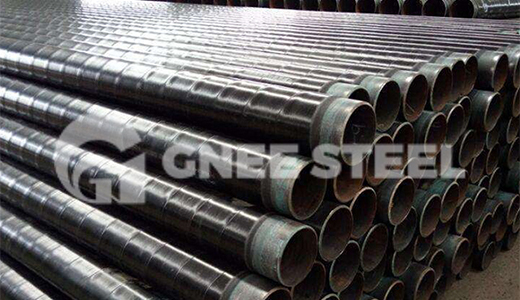3PE coating is a three-layer composite corrosion-resistant structure applied to the outer walls of metal pipes (primarily steel pipes), consisting of an epoxy powder base layer (FBE), an adhesive intermediate layer (AD), and an outer polyethylene (PE) layer. Its core characteristics and applications are as follows:

1. Coating Structure and Function
Base Layer: Fusion-bonded Epoxy Powder (FBE)
Thickness: >100 μm, applied via electrostatic spraying and melted to solidify onto the steel pipe surface, forming strong chemical bonds to provide a foundational corrosion barrier and high adhesion.
Adhesive Layer (AD)
Thickness: 170–250 μm, a copolymer containing branched functional groups, bonding the base layer and outer layer to prevent interlayer delamination.
Outer Layer: Polyethylene (PE)
Thickness: 1.8–3.7 mm (standard grade/reinforced grade), high-density polyethylene formed by extrusion winding, resisting mechanical damage, water and soil penetration, and chemical corrosion.
2. Core Performance Advantages
Exceptional Corrosion Resistance:
The three layers work synergistically to block soil salts, groundwater, microorganisms, and chemical media, with a design life exceeding 30 years.
Excellent Mechanical Performance:
The outer PE layer absorbs impact energy (e.g., gravel collisions, construction wear), while the inner FBE layer resists cathodic剥离, ensuring pipeline integrity.
Operating temperature range: -40°C to 80°C; reinforced grade suitable for harsh environments such as subsea and rocky terrain.
Long-term stability:
The polyethylene layer resists UV aging (protection required for outdoor storage), and the overall structure is resistant to plant root penetration and water infiltration.
3. Main application areas
Energy transportation:
Oil and natural gas long-distance pipelines (especially subsea pipelines and highly corrosive soil environments).
Municipal Engineering:
Urban gas and water main pipelines, insulation layer protection for heating networks.
Industrial Applications:
Corrosive medium pipelines in chemical plants, return water pipelines in thermal power plants, and underground sprinkler systems in coal mines.
Agriculture and Environmental Protection:
Irrigation water pipelines, wastewater discharge pipelines, and corrosion-resistant engineering for bioreactors.